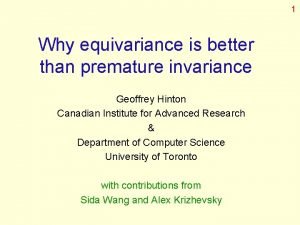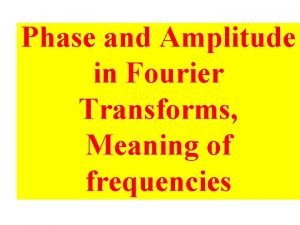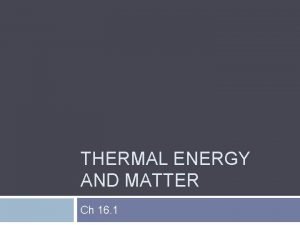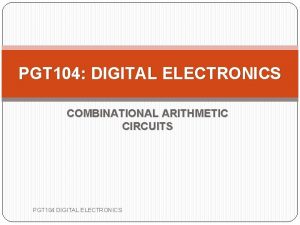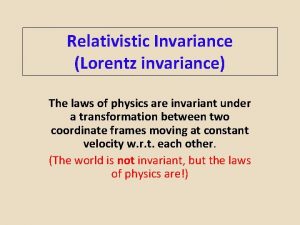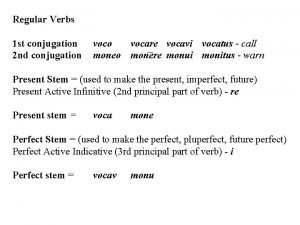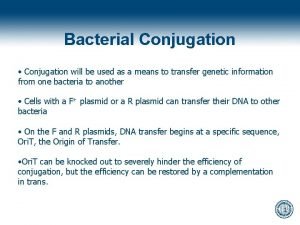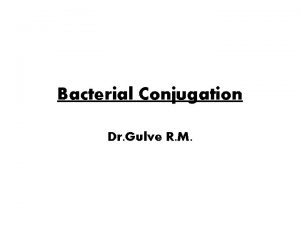Charge Conjugation Invariance Charge conjugation reverses the sign








- Slides: 8

Charge Conjugation Invariance Charge conjugation reverses the sign of electric charge Maxwell’s equations remain invariant! (charge/current density and the things derived from them: E and H just change sign) In Relativistic Quantum Mechanics this is generalized to particle antiparticle exchange Proton p Antiproton p Electron e- Positron e+ Photon g Q B L m +2. 79 -e -1 0 +e +1 0 ½ћ eћ 2 mc -e 0 +1 eћ -2. 79 2 mc -eћ 2 mc ½ћ ½ћ +e 0 -1 0 0 0 +eћ 2 mc 0 ½ћ ћ

Charge Conjugate Operator C 2| p > = | p > Obviously on a proton state but applied singly C| p > = | p > or even Although C| + > = | - > | + > C | > = | > Particles that are their own antiparticle are eigenstates of C i. e. plus the mesons at the centers of all our multiplet plots: , ,

E and B fields change sign under charge conjugation C | > = -| > it makes perfect sense to assign the photon c = -1 Then the dominant decay mode of p tells us c (p 0 ) = (-1) = +1 + like parity, a multiplicative quantum number This seems to explain why or why p 0 w p 0

While strong and electromagnetic interactions (productions or decays) are invariant under CHARGE CONJUGATION weak interactions: C : ( + m + + n m ) - m - + n m both left-handed ? ? ? Recalling that Dirac particle/antiparticle states have opposite parity maybe the appropriate invariance is to a simultaneous change of particle antiparticle with parity flipped! CP : ( + m. L+ + n. L m) - m. R- + n. R m restores the invariance!

considering the observed neutrino states Neutrino, n spin, momentum, s n spin, momentum, Neutrino, n p p spin, s momentum, CP C anti. Neutrino, P pseudovector s anti. Neutrino, n spin, momentum, p s p

K 0 = ds K 0 = sd C C | K 0 > = | K 0 > CP | K 0 > = - | K 0 > antiparticles of one another K 0 s are pseudo-scalars same pseudo-scaler nonet as s and s So the normalized eigenstates of C P (the states that serve as solutions to the equations of motion) must be and CP | K 1 > = + | K 1 > CP | K 2 > = - | K 2 >

CP | K 1 > = + | K 1 > CP | K 2 > = - | K 2 > Here K 1 and K 2 are NOT anti-particles of one another but each (up to a phase) is its own anti-particle! Different CP states must decay differently, if the weak interaction satisfies CP invariance! K 1 CP = +1 final states : p+p- or p 0 p 0 K 2 CP = -1 final states : p+p-p 0 or p 0 p 0 p 0 and, in fact kaon beams are observed to decay differently along different points of their path! K 1 “long”-lifetime 10 -8 sec (travel ~3 km before decaying! K 2 “short”-lifetime 10 -11 sec (travel ~5½ m before decaying!

1955 Gellmann & Pais Noticed the Cabibbo mechanism, where was the weak eigenstate, allowed a 2 nd order (~rare) weak interaction that could potentially induce the strangeness-violating transition of Ko Ko a particle becoming its own antiparticle! Ko Ko s d s u u W- s d W- d Ko u u d W+ s Ko
 All traffic signs and meanings
All traffic signs and meanings Invariance property
Invariance property Equivariance
Equivariance Fourier transform amplitude and phase
Fourier transform amplitude and phase Lavaan measurement invariance
Lavaan measurement invariance Bilinear transformation vs impulse invariance
Bilinear transformation vs impulse invariance Which reverses the normal flow of thermal energy
Which reverses the normal flow of thermal energy It reverses the value of a boolean expression
It reverses the value of a boolean expression A demux basically reverses the function of a mux.
A demux basically reverses the function of a mux.


